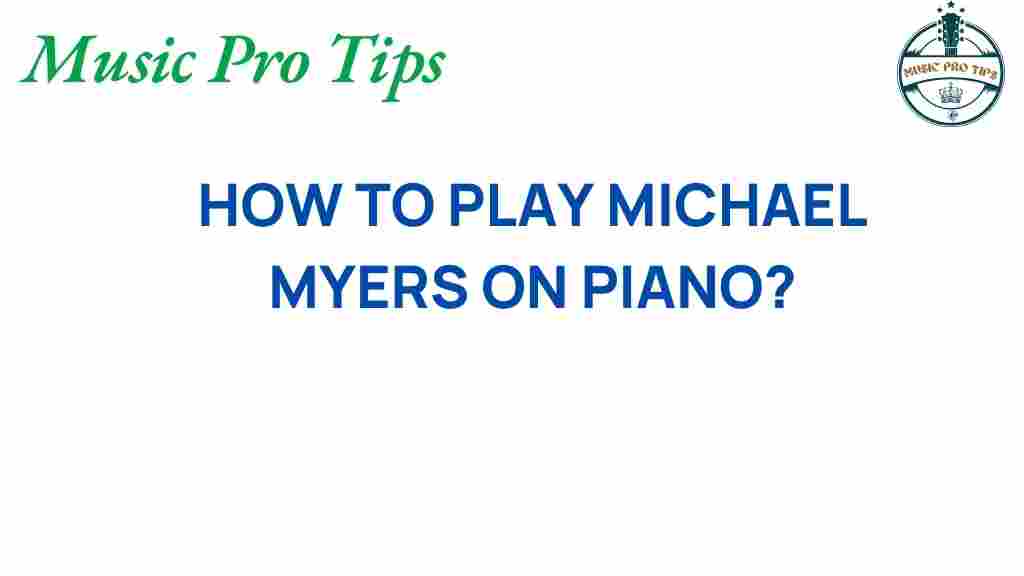Unleashing the Chills: How to Play Michael Myers on Piano
As Halloween approaches, many people seek to immerse themselves in the chilling atmosphere that the season brings. One of the most iconic figures in horror is Michael Myers, the silent, menacing figure from the “Halloween” film series. His haunting theme, composed by John Carpenter, is a staple in horror music and has captivated audiences for decades. In this article, we’ll explore how to play Michael Myers’ theme on piano, delve into the music theory behind it, and provide you with resources such as sheet music and piano tutorials to help you master this iconic piece.
The Essence of Michael Myers’ Theme
The theme for Michael Myers is more than just a collection of notes; it embodies the essence of horror. Its simple yet effective structure makes it memorable and chilling. The use of dissonance, repetition, and a minor key creates an unsettling atmosphere that perfectly complements the character’s presence on screen.
Gathering Your Resources
Before we dive into the piano tutorial, it’s essential to gather all necessary resources:
- Sheet Music: Look for reliable sources that offer sheet music for Michael Myers’ theme. Websites such as MusicNotes provide downloadable options.
- Piano Tutorials: YouTube has numerous channels dedicated to piano tutorials, where you can find step-by-step instructions on playing the piece.
- Music Theory Background: Understanding the basics of music theory will enhance your ability to interpret the sheet music effectively.
Step-by-Step Process to Play Michael Myers on Piano
Now that you have your resources ready, let’s break down the process of playing Michael Myers’ theme on piano into manageable steps.
Step 1: Familiarize Yourself with the Melody
Before attempting to play, listen to the original track multiple times. Pay attention to the melody and how it builds tension:
- Listen to the piece in different contexts, such as during the film and standalone performances.
- Try to hum or whistle the melody to internalize it.
Step 2: Analyze the Sheet Music
Once you have a grasp of the melody, take a look at the sheet music:
- Identify the time signature and key signature. Michael Myers’ theme is typically in a 4/4 time signature and a minor key.
- Notice the use of dynamics and articulation marks. These elements will help convey the mood of the piece.
Step 3: Break It Down into Sections
To simplify your practice, break the piece down into sections. Focus on one section at a time:
- Practice the right hand melody first. Ensure your timing is accurate.
- Once comfortable, add the left-hand accompaniment. This often consists of simple chords that support the melody.
Step 4: Combine Hands for Full Play
Once you feel confident with both hands individually, it’s time to combine them:
- Start slowly, ensuring each note is played clearly.
- Gradually increase your speed while maintaining accuracy.
Step 5: Add Expression and Dynamics
The emotional impact of Michael Myers’ theme relies heavily on expression. Consider the following:
- Use the pedal to connect notes smoothly, creating a flowing sound.
- Adjust your dynamics; emphasize the louder sections while allowing softer parts to breathe.
Step 6: Practice Regularly
Consistency is key when learning a new piece. Aim for regular practice sessions, focusing on different aspects:
- Spend a few minutes on scales and arpeggios to build your technique.
- Dedicate specific time to work on challenging sections of Michael Myers’ theme.
Troubleshooting Tips for Playing Michael Myers’ Theme
As with any piece, you may encounter challenges while learning Michael Myers’ theme. Here are some troubleshooting tips:
- Struggling with Timing: Use a metronome to help maintain a steady beat. Start slow and gradually increase the tempo.
- Difficulty with Hand Coordination: Practice hands separately until you’re comfortable, then combine them at a slower tempo.
- Feeling Stuck on Dynamics: Record yourself playing and listen back. This can reveal areas needing more expression.
Conclusion: Embrace the Haunting Melody of Michael Myers
Playing Michael Myers’ theme on piano is a rewarding experience that not only enhances your musical skills but also connects you to the rich tradition of horror music in film scores. By following the structured approach outlined in this article, you can capture the chilling essence of Michael Myers and bring his iconic theme to life on your piano.
So, gather your sheet music, dive into the piano tutorial, and embrace the eerie atmosphere that this unforgettable character and his music bring, especially during the Halloween season. Whether you are a beginner or an experienced pianist, mastering this piece will surely send shivers down your spine!
For more music tutorials and resources, check out our music blog, and don’t forget to share your progress with fellow horror music enthusiasts!
This article is in the category Theory and created by MusicProTips Team
